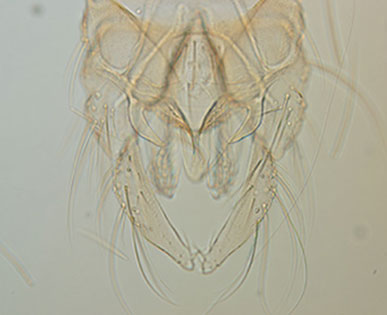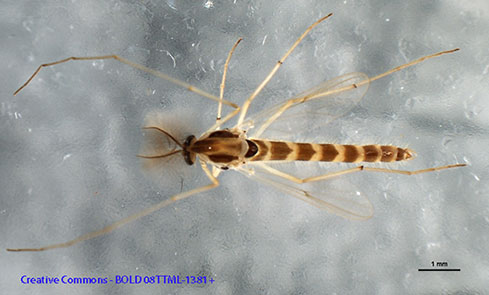Male (from Sublette & Sublette, 1974):
A darker species, thoracic markings dark brown.
Wing length about 3.64 mm; width about 0.83 mm; VR 1.06.
Foretarsus bearded, BR about 3-5.
AR about 2.64-3.64. Frontal tubercles present, about 25 µm long. Clypeus about 0.6 of the width of the antennal pedicel, with at least 14 setae.
Mesonotum with a slight hump but no discernable median tubercle.
Thoracic setae - Acrostichals in 2 staggered rows; scutellum with an anterior row of about 6 scattered setae, and a main row of about 12 long setae.
Legs with tibiae infuscate yellow, middle and hind tarsi becoming darkened apically; foretarsus bearded. Leg lengths (units) and proportions:
| Fe
| Ti
| Ta1
| Ta2
| Ta3
| Ta4
| Ta5
| LR
| F/T
| BR
|
PI
| 75
| 76
| 100
| 55
| 41
| 16
| -
| 1.32-1.66
| 0.99
| 3.0-5.0
|
PII
| 85
| 78
| 48
| 28
| 20
| 14
| 9
| 0.56-0.65
| 1.09
|
|
PIII
| 98
| 102
| 75
| 45
| 32
| 20
| 10
| 0.70-0.79
| 0.96
|
|
Dark band across base of each abdominal segment I-V, with apical area paler infuscate yellow, similar to C. bifurcatus. About 10-14 setae in an essentially trianglar clear patch on tergite IX.

Male hypoygium of Chironomus maturus (Courtesy P.L.Hudson)
Anal point broad, essentially same with along length; the Superior volsella is darker and heavier than in C. bifurcatus or C. decorus, closest to E(g)-type of Strenzke (1959), Inferior volsella with simple setae, as long as or longer than the anal point and to about mid point of the gonosytle, which is moderately swollen and reduces more gradually over about the posterior third, about 5+1 setae at tip.Female: Does not appear to have been described previously. This description based on a single female from Torbolton, Ontario:
Background coloration dark, as in male.
Wing length 5.05 mm, width 1.55 mm, VR 0.91; 3-4 SCf on brachiolum.
Head: Frontal tubercles 39 mm. Antennal proportions (micron) with proportion of neck in brackets: 250 (0.32) : 145 (0.32) : 160 (0.38): 132 (0.43): 250. AR - 0.37; A5/A1 - 1.0. Palps (micron): 58 : 73 : 80 : 245 : 240 : at least 360 (shriveled). Clypeal width about 240 µm, about 1.8 times diameter of antennal pedicel; 44 clypeal setae.
Thoracic setae: acrostichals - at least 17; humerals abt. 2-3 in linear arrangement but beginning about half way back to the suture; dorsocentrals - 21-24 (i.e. 24-26 including humerals); prealars - 7; supraalars - 1; scutellar - about 15 in posterior row and 6 in anterior row (total 21).
Leg coloration essentially as in male; lengths (micron) and proportions:
| Fe
| Ti
| Ta1
| Ta2
| Ta3
| Ta4
| Ta5
| LR
| F/T
| Ta4/Ti
|
PI
| 1570
| 1425
| 2050
| 1070
| 805
| 620
| 325
| 1.44
| 1.10
| 0.44
|
PII
| 1745
| 1645
| 1005
| 540
| 410
| 265
| 215
| 0.61
| 1.06
|
|
PIII
| 1985
| 2025
| 1375
| 875
| 645
| 365
| 225
| 0.68
| 0.98
|
|
(Hind sens.chaet.: at least 62)
4 setae on GcIX; 9 setae on segment X which is long and narrow, about 4.14 times longer than greatest width. Cercus with essentially straight posterior margin and ventral margin shorter than the dorsal.
Pupa: General color dark with lateral abdominal markings blackish. Length about 6.13-8.88 mm. Respiratory base abt. 200x76 (HR 2.6); 65-74 hooks in row at apex of tergite II. Usually with about 2 appressed spines on the caudolateral spurs of segment VIII, but may vary from 1-6, with some small. Swim fin with about 57-96 broad flattened taeniae.
Fourth instar larva of the plumosus-type, with long ventral tubules, posterior pair usually longer (ant. 0.9-3.4 mm, post. 0.9-3.7 mm). Length about 12.5-14.8 mm (female), 12.3-13.3 mm (male). Anal tubules about 3-4 times as long as wide. Gular region slightly darkened, frontoclypeus darkened. Ventral head length 273-304 µm.
Mentum (Fig. c) with rather rounded teeth, c1 tooth long and narrow with c2 teeth well separated (type III), 4th laterals barely reduced (type I).
Ventromentum (Fig. upper) about 205-230 µm wide and 3.3-3.6 times wider than deep; about 1.08 times the mentum width; with about 41-52 striae.
Pecten epipharyngis (Fig. a) usually with fairly uniform teeth, occasionally with an interspersed smaller tooth, about 10-19 teeth.
Premandible (Fig. lower) with broad teeth, inner tooth about 3-5 times the width of the outer tooth, both coming to relatively broad points (type D).
Antenna (Fig. b) with basal segment relatively long, about 0.4 of ventral head length and about 3.3 (2.60-4.0) times longer than wide; RO about 0.3 to 0.4 up fom base of segment, AR about 1.88 (1.7-2.0); segment lengths (micron) 127 : 36 : 12 : 12.5 : 6.; i.e. A3 much longer than A5, and only slightly shorter than A4.
Mandible (Fig. d) with third internal tooth well developed but only partially darkened (type IIIA-IIIB); about 16 (11-20) furrows on outer surface near the base; about 12.5 (11-14) taeniae in PMa; Mdt-Mat about 20-25; MTR about 0.22-0.31.
Cytology: 4 polytene chromosomes" with maturus arm combination AF, BE, CD, G.
Arm G often partly unpaired, with a subterminal nucleolus and 2 Balbiani rings whose position varies depending on the sequence. Nucleolus also in arm F.
Polymorphic in all arms except E.
mat A1: 1-2c, 10-12, 3-2d, 9-4, 15-13, 16-19
mat A2: 1a-e, 2d-3, 12-10, 2c-1f, 9-4, 15-13, 16-19
mat A3: 1a-e, 2d-3, 12-10, 16, 13-15, 4-9, 1f-2c, 17-19 i.e. from A2
mat B1: Puff with distal dark bands (groups 7-8) nearer the end of the arm than in whitseli.
mat C1: 1a-i, 10-11c, 2-6b, 9f-a, 6hg, 11d-15, 8a-g, 17-16a, 7d-6c, 17b-22
mat D1: 1a-i, 15e-11, 3-2, 16-18f, 7d-4, 10-7e, 18g-24
mat E1: 1 - 3e, 8 - 5, 9 - 10b, 4 - 3f, 10c - 13; i.e. as stigmaterus.
mat F1: 1 - 2, 15e - 3, 15f - 23
mat F2: 1, 13b - 15e, 2, 13a - 3, 15f - 23
mat G1: Large BR near center of arm with darker bands towards the nucleolus
mat G2: A large inversion from just distal of nucleolus, to just proximal of subterminal BR
mat G3: A small inversion at the distal end of the arm, which takes small BR terminal (not proven)
mat G4: Derived from G2 by a similar small inversion to that hypothesised for G3
One larva from near Yanton, S.D. was heterozygous for a whole-arm translocation which converted one chromosome from AF,BE to AB,EF, i.e. a unique re-constitution of the thummi arm combination.
Found: Manitoba - Churchill; Southern Indian Lake (Rosenberg et al., 1984)
Ontario - Copanspin Farm & Dunrobin, Central Experimental Farm (45.38°N, -75.70°W) Ottawa, Hogs Back (45.37°N, -75.70°W),
Torbolton (45.47°N, -76.05°W), all Carleton Co.; Mile 14.3, Highway 60 (45.58°N, -75.70°W), Algonquin Provincial Park, Nipissing Co.
Quebec - Lake Bédard (47.27°N, -71.12°W).
Alaska - Potters Marsh (61.054°N, -149,792°W), Anchorage Co.
California - Berkeley, Hayward, Oakland and Strawberry Canyon, Berkeley Hills, Alameda Co.;
El Cerrito, West Pittsburg, Trout Farm, Concord, Wildcat Creek, nr. El Cerroti, Jewell Lake,
Tilden Park and Antioch, Contra Costa Co.; Stateline, Eldorado Co.; Mad River Beach, Humboldt Co.;
Lakeport and Clear Lake Park, Lake Co.; Susanville, Lassen Co.; Rio Hondo, Montebello,
and Pasedena, Los Angeles Co.; Lily Lake, Marin Co.; 15 ml nw. Canby, Modoc Co.; 3 ml sw. &
1 ml. sw. Napa (38.28°N, -122.28°W), Napa Co.; Huntington Beach (33.640°N, 117.971°W), Orange Co.; Lake Almanor & Lake Davis
(39.91°N, -120.50°W), Plumas Co.; Bergh Ranch, Coachella Valley, Arlington, Good Samaritan Retirement Home, Corona,
448 Orange St., and UCR Experimental Ponds, Riverside, Palm Springs, Hidden Lake, 3 ml. n. Arlington,
& Priester Ranch, Norco, Riverside Co.; Ontario & Spring Valley Lake nr Hesperia, Apple Valley,
San Bernadino Co.; San Luis Obispo & Black Lake Canyon, San Luis Obispo Co.; Redwood City,
Laurel Creek, marshland pond Millbrae, 19th & Bayshore & 16th Ave., Hayward Park,
San Mateo, & Atherton, San Mateo Co.; Stanford Uni. (37.43°N, -122.17°W), Palo Alto & Mountain View, Santa Clara Co.;
Hat Creek, Fall River Mills, Shasta Co.; Vallejo, Dixon, & Rio Vista, Solano Co.; Cotati, Sonoma Co.
Indiana - Ridinger Lake, Kosciusko Co.
Louisiana - Fish Hatchery & Chaplain's Lake, Natchitoches, Natchitoches Ph.
New Mexico - 2 ml. Bonito Dam (33.45°N, -105.72°W), Lincoln Co.
New York - Ithaca, Tompkins Co. (type locality).
South Dakota - 2 ml. n, 2 ml w. Yankton; 3 ml. w. Yankton & Yankton, all Yankton Co.
Wisconsin - Trout Lake Limnological Station (41.02°N, -89.67°W), Vilas Co.
Shallow pools, often temporary.
Morphology of larva, pupa and adult described by Sublette & Sublette (1974). Cytology described by Wülker & Martin (1974), with sequence of arm C1 and arm D1 in Kiknadze et al. (2004).[ See also C. whitseli| Return to Index| Go to References ]
